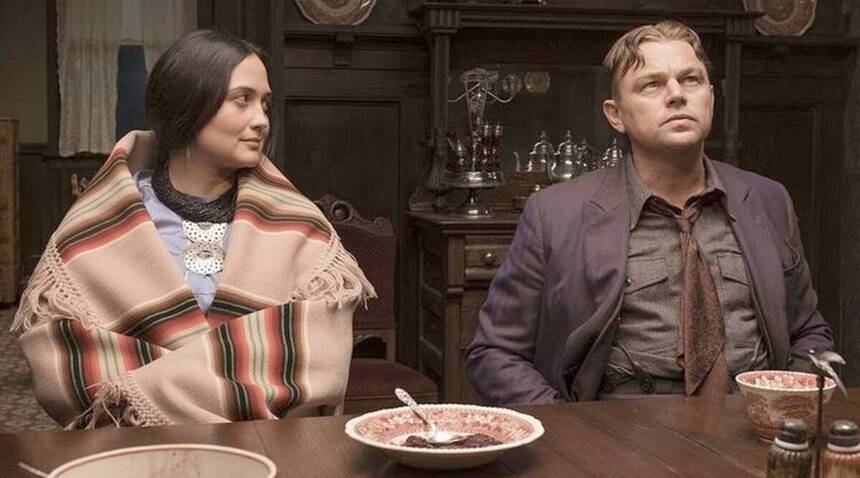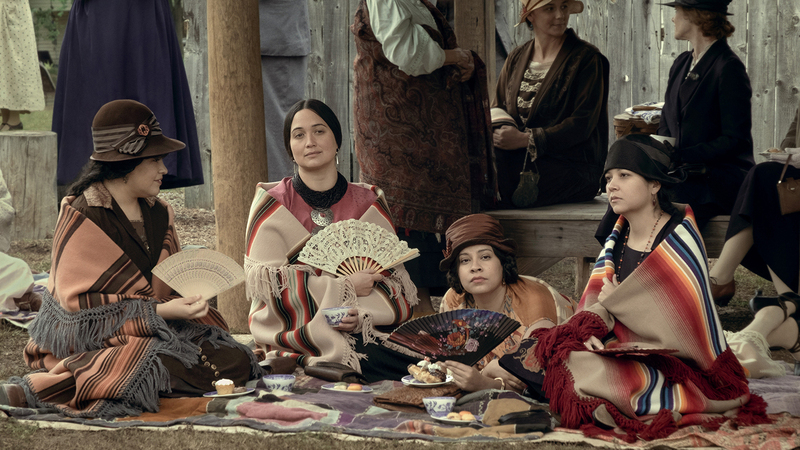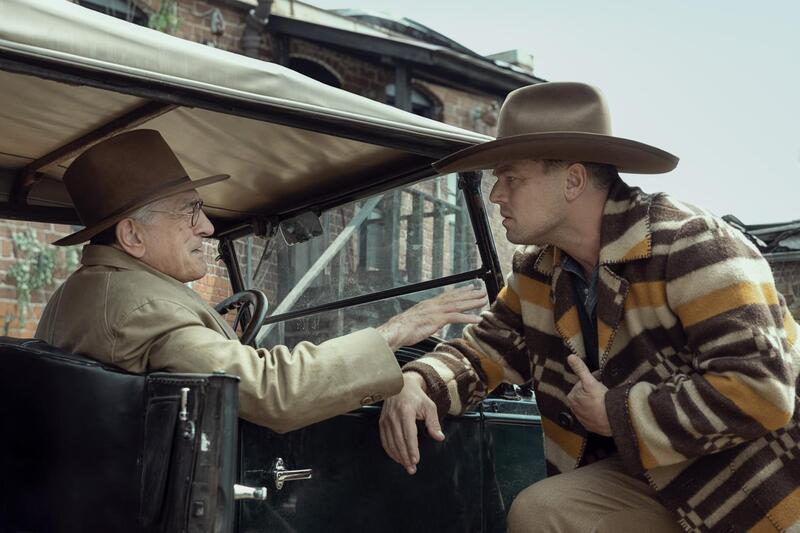KILLERS OF THE FLOWER MOON Review: Unflinching Portrayal of a Slow Genocide
Lily Gladstone shines in Martin Scorcese's epic ode to the massacre of the Osage.

There are many things to love about Martin Scorcese's directorial ambition - not the least of which, that in his twilight years, he's not going to back down from a challenge, or be unwilling to step (at least narratively) outside his comfort zone. He has been a chronicler of America for more than fifty years, to follow his often-examined themes of male ego and hubris, violence, crime, deception, guilt, and the false mythologies on which the United States is built. We might associate his work with mobsters and mafia (though his oeuvre is much larger than that - The Age of Innocence, The Last Temptation of Christ). In his latest film, he has turned his attention to another kind of organized crime, one so widespread, so insidious, with its victims so ignored by the populace and government, that is almost too horrifying to be believed. Almost.
Killers of the Flower Moon, we hope, is not Scorcese's last work. But it is perhaps, of all his historical epics and dramas about the USA, this is the one that hits closest to its proverbial heart. The story of the killings of dozens of Osage, in order to steal their money, is a microcosm of the treatment received by Indigenous peoples (not only in the USA, of course). Based on the best-selling true crime novel by David Grann, it introduces the viewer to the people with money but no power, and those with power who will use it to get the money, by any means necessary.
It could be labelled a western, but perhaps it's more accurate to say this is a post-western: this is what happened once enough 'civilization' moved in - in other worlds, once the Indigenous people had been subdued and removed from their traditional lands. No wonder, than, that Scorcese begins the film with the eyes of a child peeking into a hut - we are then taken into this hut, as the group of Osage speak in mourning, of the land they have lost, the people. There people are the heart of Scorcese's story, and we must begin (and end with them).
Forcibly moved to land that the US government assumed was worthless, the Osage discover oil. And since this is their land, they get the head rights to that oil. It makes them the richest people per capita in the world. Scorcese shows us how they used that wealth to buy cars, furs, jewels, send their children to top schools - basically, they did what any white person would do who became suddenly rich. But these are not white people, and the government forced the majority of the newly rich Osage to have 'guardians' over their money, doling out a specific amount, and rarely letting them have more — even when needed for, say, medical bills. Scorcese relates this information to us via newsreel - at once showcasing the Osage as kinds of celebrities, and positioning them via a lens through which those who would bilk them, would see them as little but objects. It also contrasts whom we would usually see in this types of stories (white people), forcing us to think about the lends through which we view.
Enter Ernest (Leonardo Dicaprio); back from serving in WWI, he goes to his uncle's in Oklahoma to find work. He has little interest in any particular occupation, not much ambition - but he does like money, and the easier he can get it the better. Lucky for him, his uncle is one William King Hale (Robert De Niro), a man who passes himself off in public as a friend of the Osage, but who makes it clear to those on the inside - who are great in number, it is slowly revealed - that he believes wholeheartedly in the myth of Manifest Destiny, and that he, and those like him, have the rightful claim to the Osage oil money. He pushes Ernest into wooing and marrying Mollie Kyle (Lily Gladstone), an Osage women whose friends and family are one by one dying, and not by any 'natural' means.
Once again Scorsese brings us intimacy across an epic. Mollie knows Ernest wants her money, and he's certainly no easy charmer, but there does seem to be love between them. But this is walking hand and hand with death. One moment, we're watching a drag race down the centre street of Fairfax, this boom town where the white people see the money and prosperity as theirs for the taking. The next moment, Mollie is walking through a sea of these white people, a voice over relating to us how she sees herself in this world, at its mercy, trying to be strong from her roots, but increasingly alone in this sea of wolves. Scorsese shows us one character, Henry Roan (William Belleau), whose sadness is taken terrible advantage of by the white men around him - in the distance, a few of these men, covered in the oil they are taking from his land, stare at him, as if to remind him that they will, indeed, take everything, and be the harbingers of his and his people's death. These moments are contrasted with the sheer brutality of how the whites dealt with the Osage - never seeing them as human, always assuming their own power over them.
 Some of these whites are content enough to charge 'Osage' prices - 10 times what they would charge anyone else for their services. Scorcese shows Hale's hand early (since it would not be too hard for us, in 2023, to know this kind of high-level manipulation when we saw it). Hale truly believes that he has the right to this money, that the Osage will die eventually and what does it matter if he hurries it along, that everything he sees should belong to him, his mask of benevolence an insult. Ernest can do little but bend under his uncle's sway.
Some of these whites are content enough to charge 'Osage' prices - 10 times what they would charge anyone else for their services. Scorcese shows Hale's hand early (since it would not be too hard for us, in 2023, to know this kind of high-level manipulation when we saw it). Hale truly believes that he has the right to this money, that the Osage will die eventually and what does it matter if he hurries it along, that everything he sees should belong to him, his mask of benevolence an insult. Ernest can do little but bend under his uncle's sway.
Eventually, the authorities outside Oklahoma are forced to deal with the problem, and an old-school lawman Tom White (Jesse Plemons), sent by J. Edgar Hoover, is not one to be swayed by Hale's charm nor frightened by his threats. White knows he has to crack the case of the murdered Osage, not just to bring this one criminal to justice, but to showcase that such investigative tactics are effective.
Both De Niro and Dicaprio embody their roles through their bodies; with a little help from costumes and hair styling, Dicarpio finds Ernest in his moments of love for his wife, and the slowly crushing burden of his secret crimes that make him stoop. He has to force himself to look Hale in the eye, so petrified he is, as one of the few who knows the evil that lurks inside. De Niro's role is perhaps a more natural fit for the actor, a person who knows how to give with one hand while taking with the other, who pretends to befriend and even believes he's doing what's right, but whose selfishness and greed will be his undoing.
But this is Gladstone's film. As Mollie, she is forced to walk a line between her Osage heritage and the white community to which she is wedded, both in marriage and through her children. She is labeled 'incompetent' while being more educated than her husband. One by one, she loses her sisters and mother, and the calm stoicism can't help but crack, as even the person she trusted the most becomes her enemy.
The cinematography work of Rodrigo Prieto (The Irishman, Barbie) is outstanding - this world is both stark in its portrayal of both the beauty of the Osage, their way of life, their rituals - Scorsese never lets us forget that this story is about them. Likewise, Robbie Robertson's (himself from the Six Nations Reserve in Ontario) score fuses traditional Osage music with modern inflection - reminding audiences that the abuse of Indigenous people still continues. The commitment to this story is clear from everyone involved, and is in every frame and sound.
Make no mistake, though, this is a Scorsese film - again, he knows that to tell this story as it needs to be told, he can and does utilize his style with the voices of those who have been forgotten. We can see the kind of criminals we are used to from his films, those whose evil runs so deep they see it as a positive; those whose weakness in the face of that evil can overrun even their deepest love. It becomes not just a post-western, but also a gangster film of sorts, and a love story that goes beyond the romantic into the political.
Killers of the Flower Moon is the one of the best of Scorsese's filmography - unflinching, honest, sweeping, intelligent, and necessary.
Killers of the Flower Moon opens worldwide on October 20th.
Killers of the Flower Moon
Director(s)
- Martin Scorsese
Writer(s)
- Eric Roth
- Martin Scorsese
- David Grann
Cast
- Leonardo DiCaprio
- Robert De Niro
- Lily Gladstone








